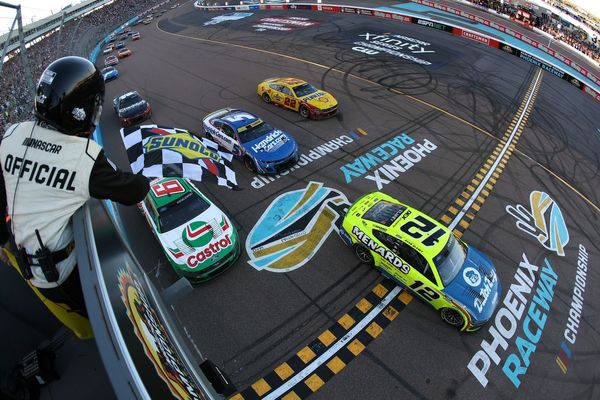
Last year, I reviewed one of Samsung’s 2017 edge-lit QLEDs, and this year I’m lucky enough to review the Q9FN, a breathtaking 65-inch flagship 4K/HDR display outfitted with full-array local dimming (FALD) and some great gaming features. It retails for a significant $3,800, and despite a few nagging flaws, this is, hands-down, the best gaming TV I’ve ever used. Read on to find out why.
Getting Started
First things first: This TV is an absolute beast. And that makes sense, since it’s 65 inches of LED technology rather than OLED, so at the most fundamental level, that means more bulk and more weight. Just getting the Q9FN out of the box is a two-person job, as is laying it down on a table or bed in order to attach the stand. This said, keep in mind that, because of the display’s size, you’ll need an equally sizable flat surface to rest it on, preferably something that can accomodate the screen’s considerable mass (I used a queen-size bed and it worked out just fine).
Once you have the TV flat and facedown, attaching the stand is extremely simple and straightforward. It comes in three pieces: Two legs and a linking bar that screw together and onto the display with a few easy clicks and some tightening with a screwdriver. The stand itself is minimalistic and boasts a nice, subdued aesthetic. It doesn’t take up too much room in front of or behind the screen, though it doesn’t raise the screen up very high, so placing a large soundbar up front can block a small portion of the screen.
Once the stand is attached, you and another person can carefully lift up the Q9FN and place it wherever you see fit. Like I previously mentioned, this is one heavy television, and so it demands a sturdy entertainment stand. That is, unless you’re planning on mounting it to the wall, in which case you can dismiss the previous requirement.
This is one of the drawbacks of QLED compared to LG’s current line of OLEDs. Once placed in a room, it’s just not very easy to move a QLED, especially if stairs are involved. That’s not to say the Q9FN’s display is thick; we’re only talking around 3 inches deep at the most. But still, it’s multiple inches compared to an inch or less with competitors’ thin displays, and those few extra inches pack quite an increase in weight. So decide where you want your QLED, because once it’s there, you probably won’t want to move it unless you have help.
Plugging In
Like previous QLEDs, the Q9FN makes use of the excellent One Connect Box, a central hub that acts as a computer brain, source splitter and all-around convenience center. All of your devices—PS4, Xbox One, Switch, Blu-ray player, etc.—plug directly into this rectangular block and feed to the screen via a thin, translucent cable. The box also has other inputs like three USB ports and optical TOSLINK.
This year’s One Connect model is slightly bulkier than last year’s (box and cable), and that seems to be because both AV and now power signals are being handled through this single connection. There’s only one wire coming from the TV itself, and that’s the cable going straight to the One Connect Box. Which is awesome, because that’s one less power cable to manage, and it’s also kind of magical, because somehow Samsung is feeding all this data and juice through something that basically amounts to clear piece of licorice. Technology is a beautiful thing.
Once everything is plugged in, initial setup is extremely simple. You can do it manually or have the TV walk you through the process via the convenient Smartthings app on your phone. The latter will grab all your WiFi and app login info (Netflix, Hulu, etc.) and teleport it to the Q9FN for immediate use, all without needing to slog through passwords and usernames with the remote.
It should come as no surprise that the Q9FN is a minimalist’s dream. A super thin bezel runs the entire gamut of the display and allows for maximum viewing real estate. And the UI, which makes a return from 2017’s lineup, is just as clean. Basically, you’ve got a navigation bar that spreads out across the bottom of the viewing area, from which you can organize and select your favorite apps. If you can manage to set up the Q9FN without any physical clutter surrounding it, the whole device looks modern, slick and stunningly design-conscious.
Gaming
The Q9FN does a lot of things right—including all manner of 4K/HDR streaming and media content—but gaming, in my humble opinion, is where it shines the brightest. Right out of the box, games look downright incredible on this display, and that’s even before the automatic Game Mode kicks in. That’s right: The Q9FN has a dedicated gaming option that overlays a sort of ideal performance optimization, utilizing FreeSync on supported content (eliminates screen tearing and stuttering, a godsend) and reducing both blur and judder. Conveniently, if you have a console connected to the One Connect Box, Game Mode will pop on all by itself as soon as a game is launched, eliminating the need to go searching through menus.
So how does Game Mode hold up? I’d say excellently, for the large part. It really does smooth things out and promote a better overall gaming experience. Though I have noticed that, in some specific games like Spider-Man and Spyro Reignited Trilogy, the mode tends to flatten colors (much more dull, in my experience) and anecdotally alters framerate/refresh rate (seemingly lowers them). Perhaps that’s the price you pay for increased performance, and having used this mode quite extensively, I’m happy to pay it.
When all is said and done, 4K HDR gaming on this set is second to none, and blows most other TVs’ gaming performance out of the water. If you have an Xbox One X, a console that has been officially partnered with Samsung’s QLED lineup, then the Q9FN is a no-brainer. PS4 Pro also looks stunning on this panel, as does whatever PC title you want to throw at it. I ran Shadow of the Tomb Raider on max settings and my eyes almost melted. The same could be said of any 4K HDR nature content I tried, things like Planet Earth II, though that’s getting sidetracked with non-gaming topics.
Just to give you a sampling, here’s a list of some of the games I’ve been testing out on the Q9FN, all with varying stunning results:
- Starlink: Battle for Atlas
- Shadow of the Tomb Raider
- Red Dead Redemption 2
- Overwatch
- Spyro Reignited Trilogy
- Crash Bandicoot N. Sane Trilogy
- Fortnite
- Strange Brigade
- Titanfall 2
- Spider-Man
- Sea of Thieves
Drawbacks
As amazing as the Q9FN is, it does have one issue that prevents it from being absolutely sublime: Uniformity. I understand that, not unlike meals or novels or songs, no electronic display is perfect. There’s always going to be some measure of imperfection that guys like me will find and fixate on, no matter how small or unnoticeable to your average consumer. But after trying three different review units (sorry Samsung PR team!), it seems that screen uniformity is the Q9FN’s achilles heel.
What do I mean by uniformity? A couple things, actually. Let’s start with something known as banding, which essentially amounts to unevenly lit strips of LCD within a display. This was the biggest problem in all the review units I tried, and while it was hardly apparent during movies and TV shows, it reared its ugly head most often during gaming. That’s because any content that pans around tends to drag the picture across these bands, thus highlighting discrepancies in consistent lighting (think about adjusting the camera in a third or first-person title, or following players around on a soccer field).
It was really easy to see banding on menus with solid colors, like the Xbox One dashboard or PS4 home. As far as games go, one of the worst offenders was Sea of Thieves, especially during nighttime periods. Moving the camera resulted in a noticeable striping in hues, almost like someone had placed strips of see-through film over portions of the screen. Banding was also quite noticeable in Spider-Man and Starlink but less noticeable in brighter games like Overwatch and Fortnite. That seemed to be the criteria: The darker the scene or game, the more noticeable the banding. I know that this was an issue with some QLEDs last year and Samsung fixed it with a firmware update, so fingers crossed the same happens with the 2018 models.
The other issue, and it’s been way less of a bother than the banding, is some slight DSE, or dirty screen effect. If you’re unfamiliar with this, it’s exactly what it sounds like: Parts of the screen appear as if they’ve been smudged with dirt, only you can’t clean it off because it’s on the inside of the display. Like I said, this wasn’t nearly as problemsome as the banding, but it was definitely present on a smaller, more insignificant level. Not sure if this can be addressed with future firmware updates (probably unlikely), so it might be more of a panel lottery issue that, if it crops up, unlucky buyers just have to deal with.
The Final Word
Despite some annoying uniformity concerns, the Q9FN is easily the best gaming TV I’ve ever used. Yes, the banding specifically is something that bothers me, and I think a quality control problem like this one is a tad unacceptable on such an expensive display. Still, the fact that I’m able to mostly overlook it is a serious testament to the Q9FN’s otherwise amazing performance. The TV looks great, it’s simple to use and delivers some of the most engaging picture quality I’ve ever seen. I haven’t yet managed to game on one of LG’s C8 panels, but until that moment arrives, this is where you’ll find me, getting owned in Fortnite and collecting every last gem in Spyro Reignited Trilogy.
Disclosure: Samsung provided review product for coverage purposes.







